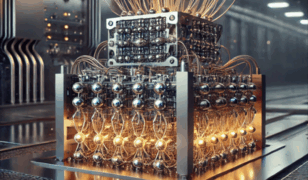Nearly 20 quantum computing companies have been chosen to enter the initial stage of DARPA’s Quantum Benchmarking Initiative (QBI), in which they will characterize their unique concepts for creating a useful, fault-tolerant quantum computer within a decade.
QBI, which kicked off in July 2024, aims to determine whether it’s possible to build such a computer much faster than conventional predictions. Specifically, QBI is designed to rigorously verify and validate whether any quantum computing approach can achieve utility-scale operation — meaning its computational value exceeds its cost — by the year 2033.
“We selected these companies for Stage A following a review of their written abstracts and daylong oral presentations before a team of U.S. quantum experts to determine whether their proposed concepts might be able to reach industrial utility,” said Joe Altepeter, DARPA QBI program manager. “For the chosen companies, now the real work begins. Stage A is a six-month sprint in which they’ll provide comprehensive technical details of their concepts to show that they hold water and could plausibly lead to a transformative, fault-tolerant quantum computer in under 10 years.”
The following companies are pursuing a variety of technologies for creating quantum bits (qubits) — the building block for quantum computers — including superconducting qubits, trapped ion qubits, neutral atom qubits, photonic qubits, semiconductor spin qubits, and other novel approaches listed below:
- Alice & Bob — Cambridge, Massachusetts, and Paris, France (superconducting cat qubits)
- Atlantic Quantum — Cambridge, Massachusetts (fluxonium qubits with co-located cryogenic controls)
- Atom Computing — Boulder, Colorado (scalable arrays of neutral atoms)
- Diraq — Sydney, Australia, with operations in Palo Alto, California, and Boston, Massachusetts (silicon CMOS spin qubits)
- Hewlett Packard Enterprise — Houston, Texas (superconducting qubits with advanced fabrication)
- IBM — Yorktown Heights, NY (quantum computing with modular superconducting processors)
- IonQ — College Park, Maryland (trapped-ion quantum computing)
- Nord Quantique — Sherbrooke, Quebec, Canada (superconducting qubits with bosonic error correction)
- Oxford Ionics — Oxford, UK and Boulder, Colorado (trapped-ions)
- Photonic Inc. — Vancouver, British Columbia, Canada (optically-linked silicon spin qubits)
- Quantinuum — Broomfield, Colorado (trapped-ion quantum charged coupled device (QCCD) architecture)
- Quantum Motion — London, UK (MOS-based silicon spin qubits)
- Rigetti Computing — Berkeley, California (superconducting tunable transmon qubits)
- Silicon Quantum Computing Pty. Ltd. — Sydney, Australia (precision atom qubits in silicon)
- Xanadu — Toronto, Canada (photonic quantum computing)
Companies that successfully complete Stage A will move to a yearlong Stage B, during which DARPA will rigorously examine their research and development approach, followed by a final Stage C where the QBI independent verification and validation (IV&V) team will test the companies’ computer hardware.
“During Stage B we’ll thoroughly review all aspects of their R&D plans to see if they can go the distance — not just meet next year’s milestones — and stand the test of trying to build a transformative technology on this kind of a timeline,” Altepeter explained. “Those who make it through Stages A and B will enter the final portion of the program, Stage C, where a full-size IV&V team will conduct real-time, rigorous evaluation of the components, subsystems, and algorithms – everything that goes into building a fault-tolerant quantum computer for real. And we’ll do all these evaluations without slowing the companies down.”
QBI is not a competition between companies; rather, it aims to scan the landscape of commercial quantum computing efforts to spot every company on a plausible path to a useful quantum computer.
DARPA recently announced that Microsoft and PsiQuantum are entering the third and final phase of the Underexplored Systems for Utility-Scale Quantum Computing (US2QC) program, a pilot effort that was expanded to become QBI. Both companies were participating in the second phase of US2QC when the QBI expansion was announced. The final Phase of US2QC has the same technical goals as Stage C of QBI – verification and validation of an industrially useful quantum computer.
“We’ve built and are expanding our world-class IV&V team of U.S. quantum experts, leveraging federal and state test facilities to separate hype from reality in quantum computing,” Altepeter said. “Our team is eager to scrutinize the commercial concepts, designs, R&D plans, and prototype hardware — all with the goal of helping the U.S. government identify and support efforts that are genuinely advancing toward transformative, fault-tolerant quantum computing.”
Source: DARPA
Your competitors read IC News each day. Shouldn’t you? Learn more about our subscription options, and keep up with every move in the IC contracting space.









